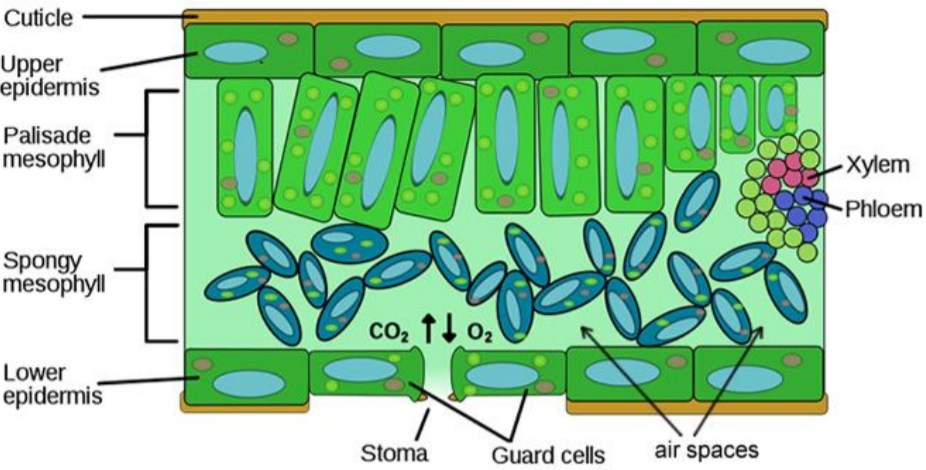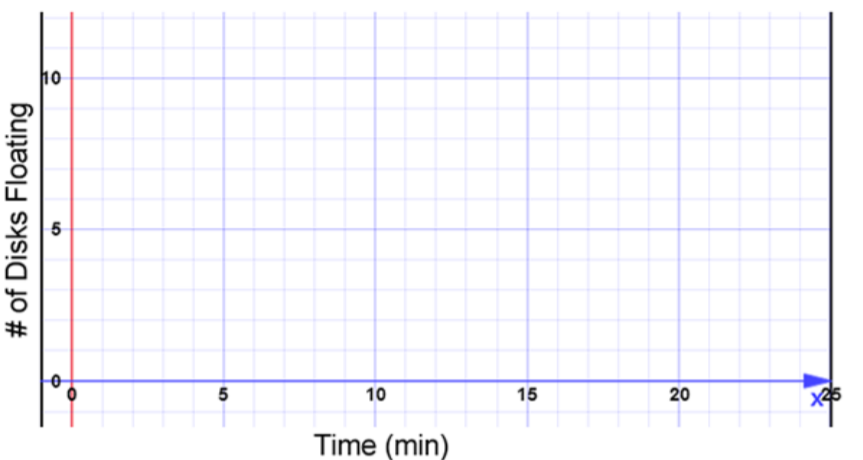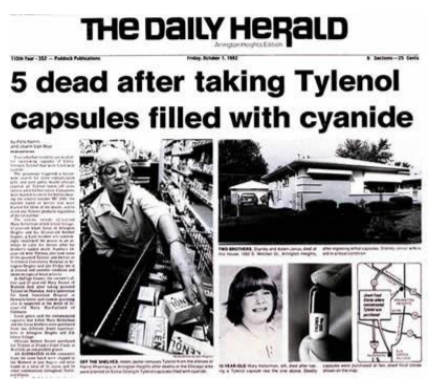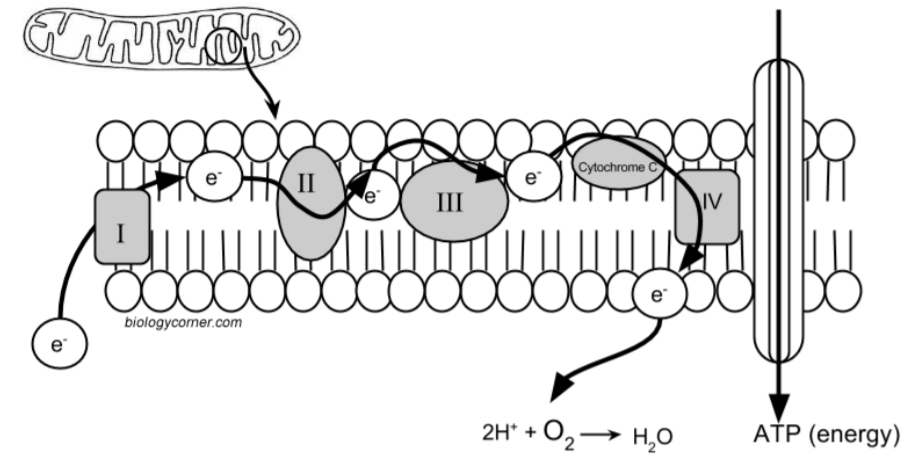what substrates or products might you monitor to determine the rate of photosynthesis
Lab 8: Cell Respiration and Photosynthesis
- Page ID
- 24111
(Adapted from Biology Corner)
Function one: Photosynthesis and Floating Leaf Disks
Introduction:
Photosynthesis fuels ecosystems and replenishes the Earth's atmosphere with oxygen. Like all enzyme-driven reactions, the rate of photosynthesis can exist measured by either the disappearance of the substrate or the aggregating of the products. The equation for photosynthesis is:
6CO2 + 6HtwoO ------light--------> C6H12Osix + 6O2 + H2O
In this investigation, you lot will utilise a system that measures the accumulation of oxygen in the leafage. Consider the beefcake of the leafage as shown below.

The leaf is equanimous of layers of cells. The spongy mesophyll layer is normally infused with gases (oxygen and carbon dioxide). Leaves will normally float in water because of these gases. If you describe the gases out from the spaces, then the leaves will sink because they get denser than water. If this leaf disk is placed in a solution with an alternate source of carbon dioxide in the form of bicarbonate ions, and so photosynthesis can occur in a sunken leaf disk. As photosynthesis proceeds, oxygen accumulates in the air spaces of the spongy mesophyll and the leaf becomes buoyant and floats. Oxygen and carbon dioxide are exchanged through openings in the leaf chosen stoma. While this is going on, the leaf is also carrying out cellular respiration. This respiration volition eat the oxygen that has accumulated and peradventure cause the plant disks to sink. The measurement tool that can be used to discover these counteracting processes is the floating (or sinking) of the plant disks. In other words, the buoyancy of the leaf disks is actually an indirect measurement of the net rate of photosynthesis occurring in the foliage tissue.
Materials:
- Syringe
- Desk lamp
- Hole punch
- Petri dishes (4 per group)
- Detergent and blistering soda solution
- Detergent solution
- Fresh spinach leaves
- Forceps
Process:
- Test the syringes past sealing the tip and pulling back on the plunger. When released, the plunger should snap back, indicating a good vacuum. Remove the plunger from a syringe.
- Use a hole punch to dial out 40 disks from the leaves. The disks should be every bit uniform in size and mass every bit possible. Avoid the larger veins of the leaves. Equally you lot punch out the leaf disks, put them into the syringe. Proceed until you have at least 40 disks.
- Tap the side of the syringe so that the disks are at the bottom, and then reinsert the plunger— being conscientious not to crush the leaf disks.
- Insert the tip of the syringe into the beaker and describe a minor corporeality of the detergent solution into the syringe. Tap the syringe to dislodge disks that are stuck to the sides. At that place may be a couple of disks that you lot merely cannot dislodge.
- Agree the syringe vertically, with the tip pointed upwards, and push in the plunger to expel the trapped air.
- Shut the tip of the syringe with your finger and pull on the plunger to create a vacuum. The vacuum removes gas from the leaf tissues. Concord the plunger in identify for 10 seconds and release it. When y'all release the plunger, liquid infiltrates the tissue. Repeat this 3 times. As liquid infiltrates the foliage tissues, the density of the disks increases and they begin to sink.
- Employ tweezers to transfer 10 disks to each petri dish and add enough solution to cover the disks; set upwardly according to the tabular array below:
| Dish A | Dish B | Dish C | Dish D | |
| Solution | Baking Soda | Baking Soda | Baking Soda | Detergent Only |
| Placement | Directly Under Lamp | On Benchtop | On Benchtop, covered | Direct Under Lamp |
8. Turn on the light and begin recording the time. As oxygen is produced by photosynthesis, it comes out of solution and infiltrates the leaf tissue, replacing some of the
water. This decreases the density of the disks, and they begin to bladder.
ix. Record the number of floating disks in 5-minute intervals, continuing the experiment until all disks are floating. Record your data in the table below.
| Number of Disks Floating | ||||
| Time (min.) | Dish A | Dish B | Dish C | Dish D |
| 5 | ||||
| 10 | ||||
| 15 | ||||
| xx | ||||
| 25 | ||||
| thirty | ||||
Analyzing Information:
To make comparisons between experiments, a standard betoken of reference is needed. Repeated testing of this procedure has shown that the betoken at which 50% of the disks are floating (ET50) is a reliable and repeatable point of reference. In this example, the disks floating are counted at the end of each time interval.
Graph your data for each experimental grouping. Determine the ET50 for your data. Did your outcome match your expectation?

Questions:
ane. A mutation is capable of reducing the amount of chlorophyll in the leafage. Would this likewise reduce the rate of photosynthesis?
2. What about a establish that exhibits variegation… Practice areas of the foliage with chlorophyll outperform areas that lack chlorophyll? Could y'all design an experiment to exam this?
3. In this experiment, the amount of oxygen produced was observed to measure out the rate of photosynthesis. What else could yous measure to determine the rate of photosynthesis?
iv. List any factors that yous think may affect the rate of photosynthesis. Consider environmental factors that you lot could dispense during the lab.
(Adapted from http://www.biologycorner.com/workshe...spiration.html)
Part 2: Chicago Cyanide Murders—A Case Report in Cellular Respiration 
Background In September of 1982, Mary Kellerman gave her 12-year-former daughter a painkiller when she awoke during the nighttime lament of a sore throat. At 7 am. the next morning time, her girl was found complanate on the bathroom floor, and after pronounced dead.
Adam Janus, a postal worker in another Chicago suburb also died unexpectedly, though originally information technology was idea he had suffered from a center assault. While his family gathered to mourn their loss, his blood brother and sister became ill and after died.
In the days that followed, 3 more unexplained deaths occurred in nearby Chicago suburbs. Investigators found that all of the victims had taken an extra strength Tylenol hours earlier their death. They suspected that someone had tampered with the medication.
Symptoms exhibited past each of the victims included:
- weakness, dizziness, sleepiness
- flushed, vivid scarlet, skin tone
- headache
- shortness of breath and rapid breathing
- vomiting
- defoliation and disorientation
1. In your stance, are the seven deaths connected? What additional information would you need to make up one's mind if they are connected?
2. If poison is suspected in the deaths, how would yous proceed with the investigation?
Autopsy Report:
The medical examiner concluded that each of the victims had died of hypoxia. Hypoxia ways that the person suffered from a lack of oxygen, or they were suffocated. The reason for the hypoxia is not ever clear at the commencement examination.
The medical examiner also showed the tissue samples from the heart, lungs, and liver showed massive cell death. On further investigation, it was shown that the tissues had major mitochondrial damage. Fifty-fifty though the victims died of hypoxia, their level of oxygen in their blood was approximately 110 mm Hg. The normal range is 75-100 mm Hg.
ane. Recall your knowledge of the function of organelles. What function of the cells was interrupted in these patients?
two. While poison is the principal doubtable in the case, what are other ways a person could die of hypoxia?
3. Clarify the oxygen levels of the victims. Were the levels higher or lower than normal? How can you reconcile this observation with the cause of death beingness hypoxia?

Toxicology reports bear witness that the victims had been poisoned with cyanide. The poison was traced back to extra strength Tylenol where the murderer had opened the capsules and replaced acetaminophen (a pain killer) with cyanide. Cyanide acts very quickly, often killing within minutes of ingestion and government were irksome to place the cause of the deaths. One time the cause every bit identified, stores removed Tylenol and other drugs from shelves. While at that place were many suspects, no one was ever charged with the crime and information technology is still an ongoing investigation. Since the Chicago Tylenol murders, drug companies have drastically inverse how medicines are packaged.
Why is cyanide such an constructive toxicant? You might be surprised to acquire that it straight interferes with cellular respiration that occurs in the mitochondria.
iv. Recall that the mitochondrion is sometimes called the "powerhouse" of the jail cell. What does this mean? Why is the mitochondrion important?
Why Practise We Need Oxygen?
It seems similar a unproblematic question, everyone knows you demand to breathe to live. Have you lot e'er thought about why oxygen is then of import? The victims of the cyanide poisoning all had loftier levels of oxygen in their blood, merely the poisonous substance was interfering with how the cells use that oxygen. To sympathize, we demand to take a very close expect at the structure of the mitochondrion.

Inside the mitochondrion, there are several layers of membranes. In fact, these membranes resemble the membrane that surrounds the cell. Information technology has a bilayer of phospholipids and embedded proteins. On the diagram to a higher place, the proteins are labeled I, II, Iii, Iv, and cytochrome C.
The proteins in the membrane pass electrons from 1 to the other; this is known as the electron transport chain. The passing of these electrons allows ATP (adenosine triphosphate) to be generated. At the end of the electron transport chain, cytochrome C passes the electron to Complex 4 and then to its final acceptor, oxygen. Oxygen then binds with proteins to create water. This process is continuous in cells, with ATP constantly being generated and oxygen existence used as the final electron acceptor. Cyanide inhibits cytochrome C, preventing the last protein from doing its job. The electron stops at the end of the chain and cannot be passed to oxygen. The whole chain grinds to a halt and no ATP can be made.
1. On the model of the mitochondrion, highlight the expanse that is the ELECTRON TRANSPORT Concatenation. Identify an Ten over the protein that is inhibited by cyanide. What is the relationship between the ETC and oxygen?
two. Cyanide is an extremely fast acting poisonous substance. In fact, it was developed as a suicide pill (called Lpill) during Globe War II so that British and American spies could avert existence captured alive. Given what you lot know about ATP and cellular respiration, explicate why cyanide is then fast acting.
3. Given what you know about cyanide poisoning, do you think that giving a person oxygen would be an constructive treatment? Why or why not?
Source: https://bio.libretexts.org/Learning_Objects/Laboratory_Experiments/General_Biology_Labs/BIOL_1107:_Principles_of_Biology_I_Lab_Manual_%28Burran_and_DesRochers%29/Lab_08:_Cell_Respiration_and_Photosynthesis

0 Response to "what substrates or products might you monitor to determine the rate of photosynthesis"
Post a Comment